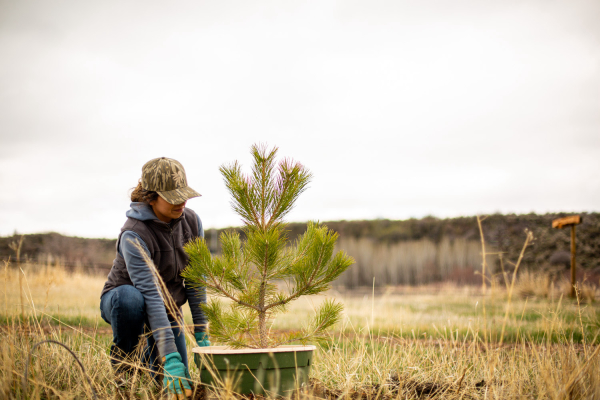

|
EDGEFIELD, S.C.—The National Wild Turkey Federation is proud to announce its upcoming Conservation Week and is challenging all to partake in conservation by getting outdoors.
The week will begin Sept. 19 with a message to join in on the greater conservation story by getting outdoors and will conclude on Sept. 25, which is National Hunting and Fishing Day. The celebratory day brings together sportsmen and women to celebrate rich traditions. The NWTF urges all outdoors enthusiasts to help promote our passions and educate others on the importance of this week.
“We want to highlight all of our own conservation and outreach work, while emphasizing the important role hunting plays in conservation,” NWTF CEO Becky Humphries said. “The connection between conservation and hunting is the essence of the NWTF’s mission, and we want to bring that relationship into focus during our Conservation Week.”
NWTF’s Conservation Week will bring awareness and emphasis to its conservation mission and the role of hunters in creating Healthy Habitats and Health Harvests by illustrating the organization’s milestones and ongoing initiatives to conserve the wild turkey and preserve our hunting heritage, specifically through the lens of the NWTF’s America’s Big Six of Wildlife Conservation.
America's Big Six of Wildlife Conservation is a national strategic plan created by NWTF conservation experts. Six areas of concern were established to help identify the most urgent needs and better monitor conservation objectives:
The Big Six of Wildlife Conservation includes 738 million acres of identified areas of concern. The NWTF focuses many of its resources on these areas to improve wildlife habitat and bolster its mission. By utilizing the Big Six strategic plan, NWTF funds have a greater impact on each area’s conservation needs.
Conservation objectives within the Big Six include:
Moreover, NWTF’s “Conservation Evolution” builds upon its Big Six of Wildlife Conservation with landscape-level conservation initiatives. The NWTF works alongside state, federal and private partners to deliver key conservation components through these initiatives:
“These high-impact conservation delivery efforts build upon our past successes and magnify our future efforts to accomplish the right work, at the right place and at the right scale,” said Tom Spezze, NWTF national director of field conservation and state policy. “These efforts focus on ours and our partners’ Four Shared Values: Clean Water, Healthy Forests and Wildlife Habitat, Robust Recreation Opportunities and Resilient Communities. These four ‘pillars of conservation’ maintain our laser-focused mission on the wild turkey and turkey hunters, while also opening new doors and opportunities for nontraditional partners to ensure we have wild things and wild places for the foreseeable future.”
While NWTF staff and volunteers work to ensure these vital conservation objectives are met throughout Big Six areas of concern, they also work within these regions to preserve our hunting heritage, which in turn fuels conservation delivery. From field to fork events, mentored hunts, Women in the Outdoors events, and craft beer and wild game pairings, NWTF staff and volunteers are working in unison to ensure there will be future hunters and conservationists.
Throughout its Conservation Week, the NWTF will showcase accomplishments and engage its digital audience with web articles, overviews for each Big Six region, Facebook Lives, infographics, Q&As, Conservation Week-specific gear, film contest results and much more.
“We want to showcase the immense breadth of the NWTF’s mission and celebrate all of our milestones and ongoing work, but we also want to get people fired up to partake in conservation,” NWTF Chief Information Officer Jason Burckhalter said. “What better way to do that than to challenge everyone to get outdoors?”
About the National Wild Turkey Federation
When the National Wild Turkey Federation was founded in 1973, there were about 1.3 million wild turkeys in North America. After decades of work, that number hit a historic high of almost 7 million turkeys. To succeed, the NWTF stood behind science-based conservation and hunters' rights. Today, the NWTF is focused on the future of hunting and conservation through its Save the Habitat. Save the Hunt. initiative. Since 2012, this 10-year initiative has already eclipsed goals of conserving or enhancing more than 4 million acres of essential wildlife habitat, recruiting or retaining more than 1.5 million hunters and opening access to more than 500,000 acres for hunting and other recreation opportunities. This critical work will continue to impact wildlife habitat and our great outdoors in the final years of the initiative.
About the National Wild Turkey Federation
When the National Wild Turkey Federation was founded in 1973, there were about 1.3 million wild turkeys in North America. After decades of work, that number hit a historic high of almost 7 million turkeys. To succeed, the NWTF stood behind science-based conservation and hunters' rights. Today, the NWTF is focused on the future of hunting and conservation through its Save the Habitat. Save the Hunt. initiative. Since 2012, this 10-year initiative has already eclipsed goals of conserving or enhancing more than 4 million acres of essential wildlife habitat, recruiting or retaining more than 1.5 million hunters and opening access to more than 500,000 acres for hunting and other recreation opportunities. This critical work will continue to impact wildlife habitat and our great outdoors in the final years of the initiative.
For more information, contact Pete Muller at (803) 637-7698 or pmuller@nwtf.net